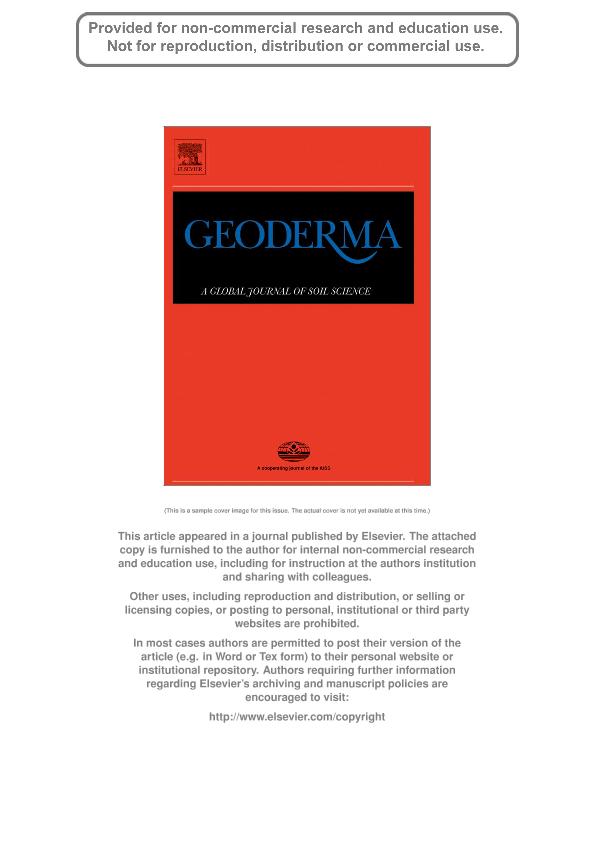Mostrar el registro sencillo del ítem
dc.contributor.author
Novelli, Leonardo Esteban

dc.contributor.author
Caviglia, Octavio Pedro

dc.contributor.author
Wilson, M. G.
dc.contributor.author
Casal, M. C.
dc.date.available
2017-07-18T21:12:27Z
dc.date.issued
2013-03
dc.identifier.citation
Novelli, Leonardo Esteban; Caviglia, Octavio Pedro; Wilson, M. G.; Casal, M. C.; Land use intensity and cropping sequence effects on aggregate stability and C storage in a Vertisol and a Mollisol; Elsevier Science; Geoderma; 195-196; 3-2013; 260-267
dc.identifier.issn
0016-7061
dc.identifier.uri
http://hdl.handle.net/11336/20883
dc.description.abstract
The relevant change in land use due mainly to the rapid expansion of soybean cropping towards areas traditionally occupied for livestock purposes or with native grasslands of South America may have negative consequences on soil organic carbon (SOC) storage and aggregate stability, although the effect may be different between soils with contrasting aggregation agents. The aim of our work was to assess the impact of the land use, measured as the intensification and/or frequency of a given crop, on SOC storage and aggregate stability in two soils differing in their main agents of aggregation. The study was conducted in a Mollisol and a Vertisol of Argentina. Eleven cropped fields (agricultural and crop-pasture rotation) under no-tillage and one uncropped situation (pristine native grassland) were selected in each soil type. The fraction of annual time with plant cover (as a measure of the intensification in the land use) and the frequency of a given crop in the cropping sequence over a 6-year period were calculated. Undisturbed soil samples were collected from each soil at 0-5, 5-15 and 15-30 cm depths. The SOC stocks in equivalent soil mass were calculated using the native grassland as the baseline system. Aggregate stability was evaluated using a method that involved three pretreatments: fast wetting, stirring after prewetting and slow wetting. The intensification improved the aggregate stability in the Mollisol, whereas a low impact of land use on aggregate stability was recorded in the Vertisol. Overall, both the intensification sequence index and the soybean cropping frequency were the best indexes to evaluate the impact of land use on aggregate stability and SOC storage, mainly in the Mollisol. The stirring after prewetting pretreatment was mainly associated with SOC concentration in the Mollisol, appearing as a method with high potential capacity to discriminate land use in the Mollisol, in which the SOC is the main aggregation agent. In contrast, the slow wetting pretreatment was more appropriate to evaluate the impact of land use in the Vertisol. The approach used to evaluate the land use, which included agricultural lands, crop-pasture rotation and native grasslands, evaluated through indexes of occupation with plant cover, was more suitable for the Mollisol than for the Vertisol. This reveals that the evaluation of land use through several indexes should be based on the soil type
dc.format
application/pdf
dc.language.iso
eng
dc.publisher
Elsevier Science

dc.rights
info:eu-repo/semantics/openAccess
dc.rights.uri
https://creativecommons.org/licenses/by-nc-sa/2.5/ar/
dc.subject
Aggregation Agents
dc.subject
Soil Carbon Stocks
dc.subject
Intensification Sequence Index
dc.subject
Soybean Cropping Frequency
dc.subject.classification
Otras Ciencias de la Tierra y relacionadas con el Medio Ambiente

dc.subject.classification
Ciencias de la Tierra y relacionadas con el Medio Ambiente

dc.subject.classification
CIENCIAS NATURALES Y EXACTAS

dc.title
Land use intensity and cropping sequence effects on aggregate stability and C storage in a Vertisol and a Mollisol
dc.type
info:eu-repo/semantics/article
dc.type
info:ar-repo/semantics/artículo
dc.type
info:eu-repo/semantics/publishedVersion
dc.date.updated
2017-07-18T20:06:45Z
dc.journal.volume
195-196
dc.journal.pagination
260-267
dc.journal.pais
Países Bajos

dc.journal.ciudad
Ámsterdam
dc.description.fil
Fil: Novelli, Leonardo Esteban. Instituto Nacional de Tecnología Agropecuaria. Centro Regional Entre Ríos. Estación Experimental Agropecuaria Paraná; Argentina. Consejo Nacional de Investigaciones Científicas y Técnicas; Argentina
dc.description.fil
Fil: Caviglia, Octavio Pedro. Instituto Nacional de Tecnología Agropecuaria. Centro Regional Entre Ríos. Estación Experimental Agropecuaria Paraná; Argentina. Consejo Nacional de Investigaciones Científicas y Técnicas; Argentina
dc.description.fil
Fil: Wilson, M. G.. Instituto Nacional de Tecnología Agropecuaria. Centro Regional Entre Ríos. Estación Experimental Agropecuaria Paraná; Argentina. Universidad Nacional de Entre Ríos. Facultad de Ciencias Agropecuarias; Argentina
dc.description.fil
Fil: Casal, M. C.. Instituto Nacional de Tecnología Agropecuaria. Centro Regional Entre Ríos. Estación Experimental Agropecuaria Paraná; Argentina
dc.journal.title
Geoderma

dc.relation.alternativeid
info:eu-repo/semantics/altIdentifier/url/http://www.sciencedirect.com/science/article/pii/S0016706112004302
dc.relation.alternativeid
info:eu-repo/semantics/altIdentifier/doi/http://dx.doi.org/10.1016/j.geoderma.2012.12.013
Archivos asociados
